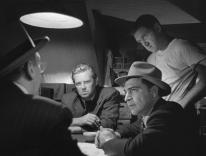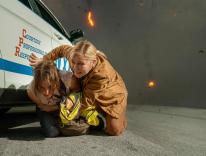The Motorcycle Diaries is about a sensitive, intelligent, and doomed youth named Ernesto Guevara, and the movie itself is sensitive, intelligent, and doomed. Scriptwriter José Rivera and director Walter Salles create interesting characters and maintain a beautiful naturalness of pace and rhythm: the movie zips along while never becoming frenetic. But it’s hard to ride a motorcycle while wearing a straightjacket, and the one Rivera and Salles share is made of left-wing piety. And around the bend lies a pothole called “Che.”
For Che Guevara is what the medical student Ernesto became: a revolutionary ready to kill for the Marxist revolution-the successful one in Cuba, and the unsuccessful one in Bolivia-that led to his execution by the Bolivian police (probably abetted by the CIA). Che was canonized by left-wingers in the late 1960s. One saw posters of him on dormitory walls and his writings were everywhere in campus bookstores; his guerrilla regalia inspired the sartorial style of the Black Panthers and the Symbianese Liberation Army, and his theories and pronunciamientos were on the lips of members of the S.D.S. It was logical enough that revolutionaries espousing violence would have a Marxist jungle fighter as a hero, yet there was one peculiar thing about the postmortem aura bestowed on Guevara by his admirers. While the posters displayed an armed warrior, and the books and aphorisms proclaimed and justified violence, his fans spoke of Che as if he were a martyr of nonviolence, a Martin Luther King, a Gandhi. I suppose it was generally felt that while a Castro or a Peron wallowed in the power he had seized, Che would never stop seeking to be a servant of the People. The violence was thus beatified into the semblance of nonviolence.
The Motorcycle Diaries tries to certify the canonization of Che by dramatizing the beginnings of Ernesto’s love for the masses. Based on writings by Guevara and his pal, Alberto Granado, Diaries is a “road movie,” a narrative that shows the mind changing while the body journeys. Guevara, a twenty-four-year-old medical student, and Granado, a twenty-nine-year-old biochemist, share a decrepit motorcycle on a 1952 trip from Argentina to Venezuela, passing through Chile, Peru, and (briefly) Colombia. The machine gives up but the young men do not. Moving through mountainous, watery, parched, and snowy landscapes, they meet many people, try to make out with any attractive female who seems willing (though Alberto is much more of a satyr than Ernesto), deal with their own exhaustion and illnesses (Ernesto has severe asthma and at one point almost dies), see many sights, including Machu Picchu, and wind up at a Peruvian leper colony where their medical skills are gratefully accepted by both staff and patients. Finally, the friends decide to return to their responsibilities in Argentina, but an epilogue reminds us of Guevara’s famous fate and Alberto’s less-famous but longer-lasting career as an important medical administrator in Castro’s Cuba.
The movie runs about 110 minutes and, if quality could be quantified, this would be a rave review because I found at least eighty minutes of Diaries to be sinewy, savory, memorable. Several scenes haunt: a Chilean girl, impressed by the big-city boys, arches her eyebrows teasingly while treating these penniless tourists to a meal; Ernesto, a wretched dancer, tries to respond to the enticement of a mechanic’s seductive wife but only infuriates her with his dopey horniness; a courteous, almost dainty landowner (beautifully acted) is suddenly panicked into truculence when Ernesto diagnoses the lump in the man’s neck as a tumor; an elderly doctor, saintly in manner and deed, but spurred by literary pretensions, has his illusion punctured by Ernesto’s withering critique of his novel, wilts, then responds with admiration for the youth’s candor. And there are at least a score of scenes and moments as memorable as these, the bounty of director Salles’s talent for casting the right faces and eliciting spontaneous emotions within cannily selected locations.
As in his previous film, Central Station, another road movie and a great one, Salles doesn’t try to lyricize landscapes or fill them with portentous menace or serenity. His camera simply follows his heroes into progressively wilder locations, never smacking us in the face with travelogue wonderments. He knows that his protagonists are gradually adjusting to the changes in landscape, so he lets us adjust as well. We remain detached enough to look around us just as the two friends look around, not with amazement but with intelligent curiosity, a curiosity that might ripen into insight.
What insights? Whose insights?
No matter what we have read by or about Guevara or Granado, their characterizations in this movie suggest a variation on that archetypal pairing that looms over all Hispanic literature and drama: Don Quixote and Sancho Panza. Ernesto is thin, dreamy, idealistic, candid, yearning to rescue the world. Alberto is fat (well, he’s supposed to be, though Rodrigo de la Serna is a bit on the thin side for the part), earthy, sometimes manipulative, determined to survive the world. In Cervantes’s classic, Sancho gets sucked into Don Q’s dream, and Cervantes fully accounts for this change in attitude. In this movie, Alberto winds up as idealistic as Ernesto but the shift is never crystallized by a specific dramatic action. More crucially, neither is the beginning of Ernesto’s revolutionary commitment. Ernesto is just as idealistic at the end of the movie as at the beginning, but he is no closer to becoming a Che, and the engendering of Che is surely the raison d’être of this film.
Not that Rivera and Salles don’t try to do this in at least two sequences. First, the travelers meet a Peruvian Indian worker and his wife who have been chased off their land by a monopoly and then harried by government forces for being Communists. This scene might have worked if we (and the youths) could be given some insight into why the Indian chose communism as the route to justice. Instead, we get rather reverent close-ups of the worker’s noble, stoic face, his prominent cheekbones and leathery skin, a certification of proletarian saintliness. The actual dialogue of the scene renders it a cliché encounter between the salt of the earth and the hopes of the future. As if that weren’t enough, the encounter is followed by a photomontage of all the other saintly workers and farmers in the area, and these stills are all in black-and-white, as if the elimination of color guaranteed purity. We also see the brutal foreman of a mining company (backed up, no doubt, by Yanqui financing), arrogantly selecting the ill-paid crew of the day while brusquely warning the city boys off company property. Ernesto throws a stone at a company truck but one stone doth not a Che make. I found the entire sequence, brief as it is, pat and patronizing.
Not so offensive, though just as generalizing and much lengthier, is the concluding sequence-the stay in the leper colony. We receive a sketchy overview of how the colony works as a hospital and social unit, and there are some nice details and incidents here. But the scene, intended to nail down Guevara’s emotional growth, is the one in which a young female patient and Ernesto form a bond. She communicates her vision of the world as nothing but a vale of tears. Provoked by this despair, the young man will become Che and try to give all the wretched of the earth a chance to enjoy life, not merely endure it. That’s the idea, at any rate. But the dialogue is too brief, too flat, and too vague to adumbrate a conversion. The overall performance of Gael Garcia Bernal as Ernesto is excellent (as is de la Serna’s as his pal), but the script keeps him at the surface of still water and we seldom see the running deep. To be fair, there is a superbly directed scene near the conclusion in which Ernesto rebels against the frailty of his body by swimming across a dangerous stream, but the determination this shows could have been channeled toward many different sorts of futures (as a doctor ministering to the poor, for instance). The question lingers: we know this young man is idealistic, but how did he become Che?
This is what I meant when I wrote of this movie’s doom. Sooner or later, the filmmakers would have to show what ignited the “Che” within Ernesto. And, no matter what incident from the Guevara/Granada writings they chose to demonstrate the conversion, it would have to be shown in a misty, hallowing light in order to maintain the saintly aura that has always coated the image of Che on both the North and South American continents. This movie is anything but iconoclastic.
But, though The Motorcycle Diaries may not be an adequate portrait of a real person’s conversion, it is a diverting and humane picaro adventure story.
Please email comments to [email protected] and join the conversation on our Facebook page.
Previous Story
Why Not Say What Happens?
Next Story
Giving Up the Ghost | by Hilary Mantel


